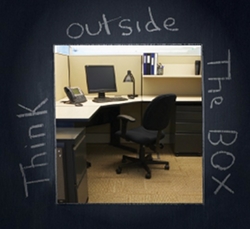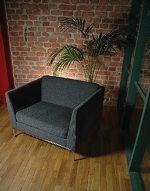by Michelle Rodwell — Is the idea that employees will be productive if they are more comfortable and inspired in their workplace believable? Given today’s turbulent economy and geopolitical turmoil, everyone is craving tranquility, but can physical space and emotion intersect to orchestrate serenity in domains? What actions can businesses take to transform their space to lift the hearts and minds of employees?
How can a business create a “return on interior” that results in a return on investment? Different business environments demand divergent returns on their interior spend. A retailer who wants to ensure a high level of foot traffic and return customers needs to create an environment is welcoming and pleasant to browse and shop in. A hospital that invites patients and visitors to patronize waiting rooms and lounges, not only needs to make sure the rooms smell clean but also project a calming, restorative feeling.
Work productivity and morale
A study conducted by the University of Exeter found that work productivity and morale could be improved by one-third by giving employees the freedom to develop the look and feel of their own office environment. The evidence suggests that empowering employees to explore their creative side and “make their desk their home” has a marked impact on their performance and sense of well-being.
The prevailing preference for lean space, which is typified by a uniform approach to design, generally leads to a heightened sense of alienation among employees, discomfort in the workplace and symptoms of sick building syndrome. The study’s findings particularly resonate in these tough economic times, when companies are more reliant than ever on productive and energetic workforces. The study squarely challenges modern methods of space management. In particular, it confronts the idea that employees perform more productively in a lean space where displays of personally or socially meaningful artifacts are forbidden.
A contemplative review of the following key factors can lead to the best ROI in regards to a positive return on interiors:
Sound satisfaction

Emotional equilibrium is rattled when people hear heavy foot traffic sounds, outside street noises or loud talking whether a person is in a restaurant, hospital waiting area or any commercial building where people congregate in mass.
A study by the American Society of Interior Designers showed that as many as 70 percent of workers believe they can work more efficiently if the workspace is quieter. Riverside Medical Center in Kankakee, Ill., USA, wanted patients, staff and visitors to have a calm oasis in their lobby which features a refreshment station and waiting area. To soften the auditory impact of foot traffic and the adjacent busy escalators, Riverside installed acoustic art with the featured image changing to reflect each season.
Acoustic art features images that are printed on a special material can absorb as much as 95 percent of the sound hitting it, compared with 3 to 5 percent that is typical of a bare wall. The material used for an acoustic collection is lightweight, recyclable and fire resistant. “The acoustic art in our hospital not only looks beautiful but it has reduced noise by 10 decibels which makes for a more tranquil and healing environment,” said Phillip M. Kambic, president and CEO of Riverside Medical Center.
Enhancing regional appeal
In 2006, Omni Hotels & Resorts was a pioneer in offering sensory branding as part of its public space amenities with the use of a green tea and lemongrass infused scent in their lobbies, and cappuccino and mochaccino-infused scenting in their Morsels cafés. More recently, Omni evolved the program and customized the scents in their properties based on the destination’s particular ambience and local color. “Each hotel in the Omni portfolio has a distinct profile in keeping with the essence of the particular destination which demands different sensory elements,” said Stephen Rosenstock, senior vice president of brand standards for Omni Hotel & Resorts.

Expressing local variances also can be displayed with art with a regional focus or by a hometown artist or with indigenous plants. Riverside Medical Center features customized art in their acoustic art that featured foliage and landscapes indigenous to their location.
Scent of satisfaction
The absence of a malodor does not mean that indoor air quality cannot be improved. Each business environment has different odor challenges. A casino or hotel’s smoking floor may feature a strong tobacco smell due to the lack of air circulation in hallways and main meeting areas. A hotel that accepts pets may have musky animal smells long after the animal has departed.
The introduction of a scent ambience into an interior space enhances indoor air quality. Sensory branding can stimulate consumers’ relationships with a brand and cultivate an emotional connection that optimizes brand loyalty. “Of all the five senses, smell is the most powerful trigger of emotions and memories,” added Rosenstock. “Guests continually comment on the cleanliness and freshness of our lobbies, hallways and meeting rooms. While most guests cannot put their finger on the origin of the scent, some guests attribute the fresh aroma in our lobby area to the lush foliage.”
Eco-conscious mindset
In the business, developing an eco-conscious mindset world goes well beyond recycling. Businesses should take a long hard look at what they can do proactively to reduce the Earth’s carbon emissions and encourage sustainability.
Riverside Medical Center did some serious out-of-the box thinking designed to help make a positive difference today and for future generations with the installation of a large eco-friendly vegetative living green roof system. The planting system and vegetation on the living roofs act as insulation and can reduce heating and cooling costs by as much as 20 percent. The green roof provides patients, visitors and employees with an ever-changing landscape canvas atop a rooftop space that previously was barren.
“Riverside Medical Center is committed, not only to the best possible care of our patients, but to also help take care of the planet and reduce our carbon footprint,” said Kambic. “The green roof was designed to help make a positive difference today and for future generations. Patients, visitors and staff now will have an aesthetically pleasing view, rather than that of an unappealing white roof.” Kambic points out that several research studies have indicated a natural view can play an important role in improving health.
A living roof encourages a different way of thinking altogether. Installing green roofs is about ensuring a commitment to address the most pressing environmental issues of our time: climate change, energy efficiency and sustainability.
Exterior, interior synergy
Retailers have long understood the importance of the interior environment in enhancing the patron’s overall experience. But while retailers are focused on the presentation of their product and store, they sometimes overlook the common areas surrounding their shop. The outdoor landscape can be the unspoiled extension of shop interiors, providing indoor and outdoor continuity for a positive shopping experience that enthralls all the senses. Interior plants and landscaping can work together synergistically to create store interiors that are more favorable for retail activity.
Restoration Hardware, founded nearly 30 years ago in Eureka, Calif., USA, is one of the leading purveyors of premium home furnishings with more than 100 retail and outlet store locations in the United States and Canada, as well as a rapidly growing direct-to-consumer business that includes standalone catalogs and e-commerce sites. “We have experienced positive feedback from our customers due to our exterior/interior synergy that showcases both indoor and outdoor environments and fosters a seamless brand experience with our retail stores, catalog and web offerings,” said David W. Block, visual merchandising manager for Restoration Hardware.
Getting creative with holiday spirit
Holidays are a wonderful chance to surprise and delight customers, clients and coworkers. Environments featuring eye-catching seasonal plant designs and holiday décor that enhances an office environment makes coworkers feel like their employer really cares and a brand can receive a bit of a boost because of the potential positive impression made on visitors.
The Intercontinental Hotel in Los Angeles, Calif., USA, opted to go nontraditional, yet stylish and simple in the 2011 holiday season. Rather than feature one giant live tree that traditionally stood at the center of the lobby, in 2011 hundreds of the hotel’s brand signature purple holiday balls were hung from the lobby ceiling at varying lengths. Thirty live trees of varying breeds and sizes were installed to provide a natural forest landscape in the lobby. The holiday scene further was complemented by fresh cut Polar Star roses, and strategically placed silver-finished, mirror-reflective and crystal household items along with white-scented French candles that were lit each evening. With all the design components in place, the lobby was transformed into a gallery of modern, stylish and breathtaking holiday splendor with an undisputed “wow” factor.
Cost consolidation and brand integrity
Many national and international retailers aim to achieve a certain uniform look and feel to their retail stores which furthers their branding goals. More managers are investigating ways to reduce costs while optimizing brand uniformity and integrity.

For example, Hugo Boss, the fashion and lifestyle house based in Metzingen, Germany, that specializes in high-end men and women’s wear, consolidated its orchid purchases across the United States with one vendor. Troubled that certain stores had dead or dying orchids on the floor, Hugo Boss wanted to ensure all orchids and vases in their stores were healthy, well maintained and reflective of their luxury brand image. By aligning with one primary vendor, they reduced costs substantially and their stores across North America feature a consistent orchid program down to a uniform number of stems, color and breed of orchids, top-dressing in the vases and even brand consistency on how the orchid stems are tied off to the support branches.
Seasonal appeal that honors nature
Business environments that honor seasonal variations can keep consumers in touch with what really matters—nature. A growing body of research demonstrates that access to a natural environment indoors may improve health and well-being. Rotating interior plants and artwork to reflect seasonal regional variances provides a nurturing visual touch point to nature.
Being around plants reduces stress and creates a feeling of well-being in most people; a benefit that is even more acute if correct lighting is in place. Because plants have a large surface area and exchange water and gases with their surroundings, they have a unique ability to tackle many environmental problems.
Reviewing your space
Creating a return on interior that results in a positive return on investment demands a focus on flexibility, creativity and sustainability. With high real estate and energy costs, every employer should carefully review their physical space to ensure maximum financial return for their business. With fewer employees doing more work, organizations understand that employees are much more likely to stay at a job when they like the environment where they work. FMJ

Michelle Rodwell is divisional vice president of marketing at Ambius, www.ambius.com/designers, a global leader in providing workplace products and services, which is a division of Rentokil Initial plc (LSE: RTO). Rodwell is a member of the American Marketing Association, Business Marketing Association and Vistage International. She can be reached at michelle.rodwell@ambius.com.